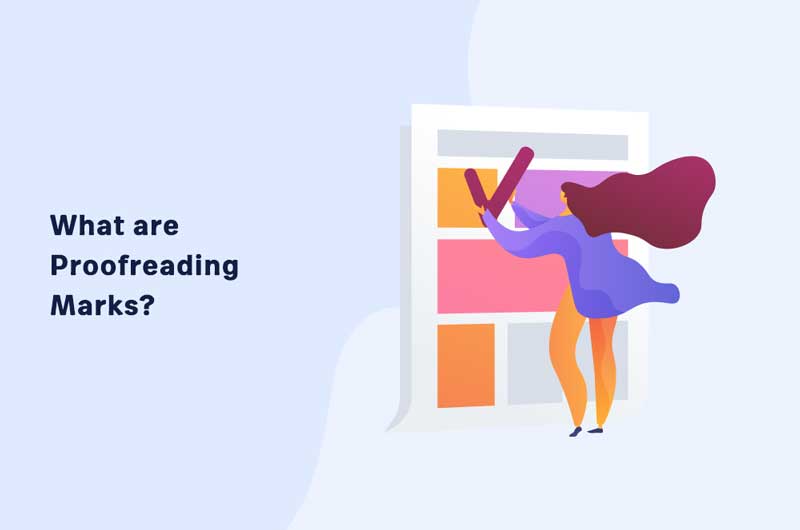If you’ve ever seen a document or copy edited by a professional proofreader, then you might have observed the various symbols marked on it. These unfamiliar symbols are called proofreading marks.
Proofreading marks are a vital part of copy editing. They can indicate anything from typos and spelling errors to changes in punctuation or grammar to the deletion of words. Even if you get intimidated by these markings, fixing these will make your copy error-free.
When proofreading your work, you must understand what each proofreading mark means to know how best to correct yourself. This blog post will take a look at some commonly seen proofreading marks and their meaning!
What are Proofreading Marks?
Proofreading marks are a set of symbols used to mark mistakes in a text. These proofreading marks are an essential part of the job for any copy editor. It’s because they will ensure that all errors have been fixed before publishing.
Instead of looking at them as confusing symbols on your document, look at them as steps to draft a perfect copy. As the proofreader can’t make changes directly on a physical document, the editor will leave the proofreader’s marks on it. If you’ve written the text, you need to look at these proofreading symbols and correct the copy.
Proofreading symbols are also different depending on the type of text. For example, in a manuscript, proofreading marks will be much more thorough than for an online copy only containing spelling mistakes or typos. All this hard work is done so that the final document or manuscript looks polished.
However, most of the proofreading is done via Google Docs or Microsoft Word. So, you won’t come across proofreading symbols very frequently if it isn’t the case of hardcopy editing.
Are Proofreading Marks Still Used?
When it comes to hardcopy editing, proofreading marks are used by many editors and professional copy checkers. Traditional proofreading services use these proofreading symbols to fine-tune their documents.
They are still used but not as much in the age of technology when you can use spellchecking and grammar check to fix your mistakes. Proofreading marks have their place, though! And they should be respected by editors and proofreaders alike as they do add value to the final copy once all errors have been corrected.
Many copy editors also rely on proofreading marks when working with manuscripts. As many authors prefer writing their manuscripts by hand instead of a Word document, editors have to check them using these symbols.
Common Proofreading Practices
Editors use proofreading marks to highlight incorrect spellings, vocabulary, grammatical errors, formatting issues, and punctuation problems. When they edit, they’ll leave these proofreading marks on both sides of the document.
They’ll leave the corrections for the first half of a sentence on the left side of the margin. For corrections on the latter half of the sentence, the marks are left on the right-hand side of the margin. Moreover, the editor will also place a marking between the text where you need to make some corrections.
You might observe a caret symbol that indicates some text needs to be added. Or, you might see a line through a text, which means you need to delete it. The proofreader’s name and date are also written on top of the page.
Usually, hard copies of documents are proofread using red ink for better visibility. It might seem intimidating, but that’s how it works!
Proofreading In Digital Documents
In contrast to proofreading on paper, editors can’t use the same methods. They’ll have to highlight mistakes using different symbols and colors in a Word document or another digital editing software.
Proofreaders’ marks are sometimes called “track changes” to show where edits were made as if you’re following a track.
Here are the types of the most common proofreading marks –
- Underlining – This indicates that there is an error in spelling or grammar.
- Italics – Used to indicate a strong emphasis on words, phrases, or sentences. It can also be used as a reader’s guide for the text meaning when reading aloud!
- Strikethrough Text – Indicates deletion from original content; often done with red ink. Some publications will use this symbol instead of deleting content altogether. This is done to avoid affecting search engine optimization (SEO) and its indexing process.
- Double underline (double line space between lines) – Shows where changes were made by different authors/editors within the copy but not yet agreed upon.
- Bold – Used to highlight important words or phrases, usually within a paragraph of text. It can also be used as an alternative way of emphasizing a word/phrase that would otherwise be italicized!
Commonly Used Proofreading Marks
Now, we will take a look at the most common proofreading marks you might notice in typeset pages or a hard copy document.
Transpose
While writing, you might get the order of some words jumbled up. On the other hand, the editor might feel that the order of some words in a sentence can be arranged better. In this case, the proofreader will put a transpose symbol, which has an abbreviation of tr.
New Paragraph
If you notice, there are a lot of periods in the paragraph. Sometimes you may want to separate your thoughts by adding some space between them. On the other hand, sometimes a paragraph may seem too packed with words and needs to split into another one for more clarity.
If your paragraphs aren’t spaced properly, the new paragraph symbol is used to insert a space between them.
Close Up Space
While writing or typing a document, you may need to insert space between two words. If this space is a little too much, the entire line will look awkward. So, the only way to fix this is to remove the extra space given.
Therefore, to indicate this, copyediting professionals use the close-up space symbol between the words that need correction.
Insert Em Dash
Sometimes, you might need to draw the reader’s attention towards a part of the sentence without breaking the flow. If you want to make a sentence more emphatic, the em dash symbol can be inserted in between any two words.
These are versatile punctuation marks that look modern and instantly affect the reader’s mind. If you haven’t inserted where you should have, the proofreader will insert the insert em dash symbol to notify you.
The Ital Symbol
This is one of the most important proofreading symbols ever used. As you might have understood, it stands for italics. It is placed where you need to use one, such as a published book title or a journal.
It is also called a typography mark and is indicated using the word ital with a circle around it.
There are other abbreviations used in proofreading, which are –
- sp (spelling) – This is used for indicating an incorrect spelling
- bf (boldface) – This symbol is used for marking where you have to use a boldface type
- [ – This denotes that you have to move the content or a few words to the left. However, the symbol should be as big as the length of the content
- ] – This denotes that you need to move the content to the right. Like the previous symbol, this also needs to be as long as your content
- DICT – It denotes incorrect diction
- REP – It indicates unnecessary repetition of words which you must correct
- R-O – This represents a run-on sentence, i.e., a sentence that doesn’t seem to end and runs on too long!
- AWK – It is used to specify an awkward sentence construction, where you need to rearrange the words to improve it
All these proofreading marks help in making the final copy perfect and also look professional. If you’re a writer, you must take time to resolve these issues before the final draft is published.
Wrapping Up
Preparing an error-free final draft of a book or script is essential to achieve the outcome – reaching the audience. When a content piece is polished and proofread, the writer can easily communicate with the reader. After all, no reader would appreciate a book having tons of spelling mistakes or incorrect punctuations, even if the story is intriguing.
As proofreading is the final stage of the editing process, the proofreading marks discussed above will help editors polish any document. If you’re a writer, we hope this article will help you decipher these symbols next time you come across them.









